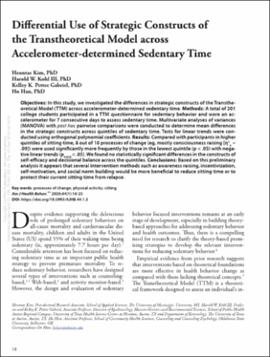| dc.contributor.author | Kim, Heontae | |
| dc.contributor.author | Kohl, Harold W., III | |
| dc.contributor.author | Pettee Gabriel, Kelley K. | |
| dc.contributor.author | Han, Ho | |
| dc.date.accessioned | 2022-04-19T20:19:33Z | |
| dc.date.available | 2022-04-19T20:19:33Z | |
| dc.date.issued | 2020-01 | |
| dc.identifier | oksd_han_differentialuseofstrategicconstructs_2020 | |
| dc.identifier.citation | Kim, H., Kohl, H. W., III, Pettee Gabriel, K. K., & Han, H. (2020). Differential use of strategic constructs of the transtheoretical model across accelerometer-determined sedentary time. American Journal of Health Behavior, 44(1), pp. 18-25. https://doi.org/10.5993/AJHB.44.1.3 | |
| dc.identifier.uri | https://hdl.handle.net/11244/335263 | |
| dc.description.abstract | Objectives: In this study, we investigated the differences in strategic constructs of the Transtheoretical Model (TTM) across accelerometer-determined sedentary time. Methods: A total of 201 college students participated in a TTM questionnaire for sedentary behavior and wore an accelerometer for 7 consecutive days to assess sedentary time. Multivariate analyses of variances (MANOVA) with post hoc pairwise comparisons were conducted to determine mean differences in the strategic constructs across quintiles of sedentary time. Tests for linear trends were conducted using orthogonal polynomial coefficients. Results: Compared with participants in higher quintiles of sitting time, 8 out of 10 processes of change (eg, mostly consciousness raising [n2p = .09]) were used significantly more frequently by those in the lowest quintile (p < .05) with negative linear trends (trend < .05). We found no statistically significant differences in the constructs of self-efficacy and decisional balance across the quintiles. Conclusions: Based on this preliminary analysis it appears that several intervention methods such as awareness raising, incentivization, self-motivation, and social norm building would be more beneficial to reduce sitting time or to protect their current sitting time from relapse. | |
| dc.format | application/pdf | |
| dc.language | en_US | |
| dc.publisher | JCFCorp SG PTE LTD | |
| dc.relation.ispartof | American Journal of Health Behavior, 44 (1) | |
| dc.relation.uri | https://www.ncbi.nlm.nih.gov/pubmed/31783929 | |
| dc.rights | This material has been previously published. In the Oklahoma State University Library's institutional repository this version is made available through the open access principles and the terms of agreement/consent between the author(s) and the publisher. The permission policy on the use, reproduction or distribution of the material falls under fair use for educational, scholarship, and research purposes. Contact Digital Resources and Discovery Services at lib-dls@okstate.edu or 405-744-9161 for further information. | |
| dc.subject.mesh | Accelerometry | |
| dc.subject.mesh | Adolescent | |
| dc.subject.mesh | Female | |
| dc.subject.mesh | Humans | |
| dc.subject.mesh | Male | |
| dc.subject.mesh | Sedentary Behavior | |
| dc.subject.mesh | Students | |
| dc.subject.mesh | Surveys and Questionnaires | |
| dc.subject.mesh | Transtheoretical Model | |
| dc.subject.mesh | United States | |
| dc.subject.mesh | Universities | |
| dc.subject.mesh | Young Adult | |
| dc.title | Differential use of strategic constructs of the transtheoretical model across accelerometer-determined sedentary time | |
| dc.date.updated | 2022-04-12T18:21:20Z | |
| osu.filename | oksd_han_differentialuseofstrategicconstructs_2020.pdf | |
| dc.description.peerreview | Peer reviewed | |
| dc.identifier.doi | 10.5993/AJHB.44.1.3 | |
| dc.description.department | Community Health Sciences, Counseling and Counseling Psychology | |
| dc.type.genre | Article | |
| dc.type.material | Text | |
| dc.subject.keywords | Prevention | |
| dc.subject.keywords | Cardiovascular | |
| dc.subject.keywords | 1117 Public Health and Health Services | |
| dc.subject.keywords | 1302 Curriculum and Pedagogy | |
| dc.subject.keywords | Public Health | |
| dc.identifier.author | ScopusID: 57205723554 (Kim, H) | |
| dc.identifier.author | ScopusID: 7102530211 (Kohl, HW) | |
| dc.identifier.author | ScopusID: 57195991119 (Pettee Gabriel, KK) | |
| dc.identifier.author | ORCID: 0000-0003-4241-7317 (Han, H) | |
| dc.identifier.author | ScopusID: 57191291072 (Han, H) | |
